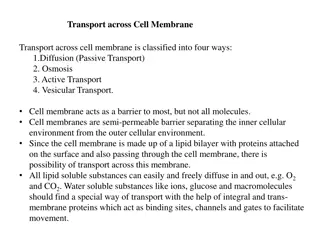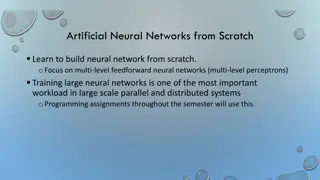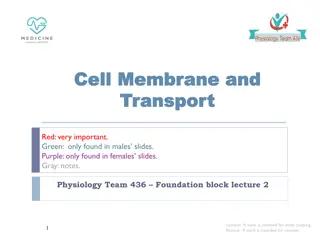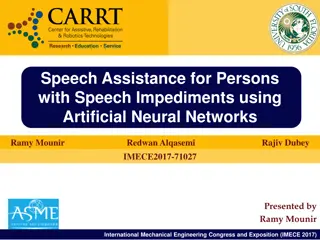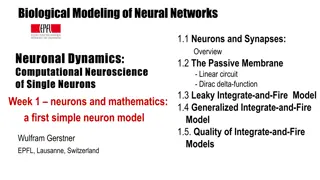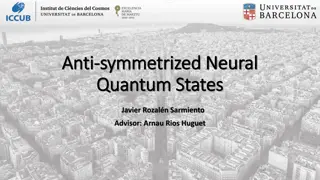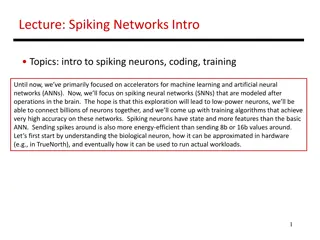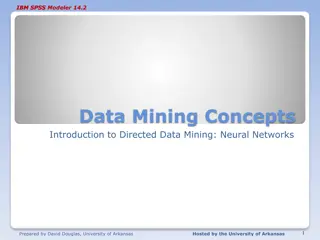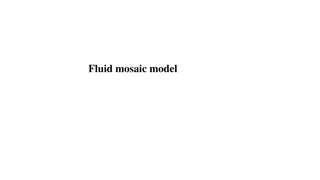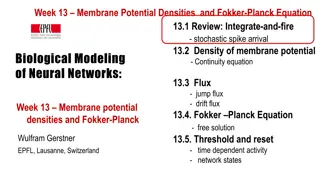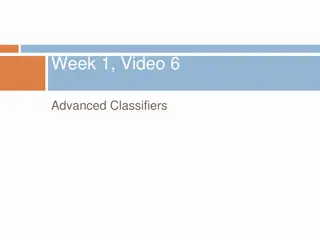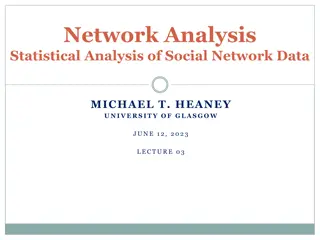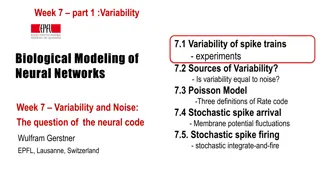Membrane Potential Variations in Neural Networks
Delve into the dynamics of membrane potential variations in neural networks through topics like white noise approximation, autocorrelation of Poisson processes, and the Noisy Integrate-and-Fire model. Investigate how these variations manifest at different thresholds, shedding light on the biological modeling of neural activity.
Download Presentation

Please find below an Image/Link to download the presentation.
The content on the website is provided AS IS for your information and personal use only. It may not be sold, licensed, or shared on other websites without obtaining consent from the author.If you encounter any issues during the download, it is possible that the publisher has removed the file from their server.
You are allowed to download the files provided on this website for personal or commercial use, subject to the condition that they are used lawfully. All files are the property of their respective owners.
The content on the website is provided AS IS for your information and personal use only. It may not be sold, licensed, or shared on other websites without obtaining consent from the author.
E N D
Presentation Transcript
Week 8 part 1 :Variation of membrane potential 8.1Variation of membrane potential - white noise approximation 8.2 Autocorrelation of Poisson 8.3 Noisy integrate-and-fire - superthreshold and subthreshold Biological Modeling of Neural Networks Week 8 Noisy input models: Barrage of spike arrivals 8.4 Escape noise - stochastic intensity 8.5 Renewal models 8.6 Comparison of noise models Wulfram Gerstner EPFL, Lausanne, Switzerland
Neuronal Dynamics 8.1Review: Variability in vivo Variability - of membrane potential? - of spike timing? Spontaneous activity in vivo awake mouse, cortex, freely whisking, Crochet et al., 2011
Neuronal Dynamics 8.1Review.Variability Fluctuations -of membrane potential -of spike times fluctuations=noise? In vivo data looks noisy relevance for coding? In vitro data fluctuations source of fluctuations? model of fluctuations?
Neuronal Dynamics 8.1.Review Sources of Variability - Intrinsic noise (ion channels) -Finite number of channels -Finite temperature Na+ K+ -Network noise (background activity) -Spike arrival from other neurons -Beyond control of experimentalist Check intrinisic noise by removing the network
Neuronal Dynamics 8.1. Review:Sources of Variability - Intrinsic noise (ion channels) Na+ In vivo data looks noisy K+ -Network noise In vitro data small fluctuations nearly deterministic
Neuronal Dynamics 8.1 Review:Calculating the mean ( k f syn = ) ( ) RI t w t t k k f t 1 k = ') ( ' f syn f = ( ) x t ' ( ) dt f t t t t ( ) ' ( ) ' t ' ( ) I t w dt t t t k k R k f f mean: assume Poisson process k f = f f syn ( ) x t ' ( ') ( ' t ) dt f t t t = = 1 ( ) ' ( ) ' ' ( ) I I t w dt t t t t 0 k k R k f = ( ) x t ' ( ') ( ') t dt f t t k = ' 1 ( ) ' I w dt t t 0 k k R rate of inhomogeneous Poisson process
Neuronal Dynamics 8.1. Fluctuation of potential for a passive membrane, predict -mean -variance of membrane potential fluctuations Passive membrane d syn = + ( ) ( ) u u u R I t rest dt Passive membrane =Leaky integrate-and-fire without threshold
Neuronal Dynamics 8.1. Fluctuation of current/potential Synaptic current pulses of shape k f syn = EPSC ( ) ( ) RI t w t t k k f Passive membrane (t ) R I RI 0 d syn syn fluct = + = + ( ) ) ( t u u u R I ( ) ( ) I t I I t rest 0 dt = + syn ( ) t ( ) ( ) t ( ) t RI RI t 0 I(t) = 0 0I ( ) ( ') t = t t 2 ( ') t a Fluctuating input current
Neuronal Dynamics 8.1 Calculating autocorrelations = + ( ) I t ( ) ( ) t I t 0 I(t) Autocorrelation 0( ) I t Fluctuating input current = ( ) ( ') x t x t = dt f t t I t ( ) x t ' ( ') ( )' = ( ) x t ( ) ( ) ds f s I t s Mean: = ( ) x t ( ) ( ) ds f s I t s = + t s ( ) x t ( ) [ ( ) ( ) ] ds f s I t s 0 = dt f t t f t t ( ) ( ) x t x t ' " ( ') ( ") ( ') ( ") I t I t dt = ( ) x t ( ) ( ) ds f s I t s 0
White noise: Exercise 1.1-1.2 now Assumption: far away from theshold (t ) u (t ) u Input starts here Next lecture: 9:56 = Expected voltage at time t ( ) ? u t Variance of voltage at time t 2 = = ( ) ( ) ( ) ( ) ( ) u t u t u t u t u t
Diffusive noise (stochastic spike arrival) d = + + ( ) ( ) ( ) u u u R I t t rest (t ) u dt = ( ) ( ) u t u t 0 2 = = ( ) ( ) ( ) ( ) ( ) u t u t u t u t u t ( ') u t = = ( ) ( ) ( ') u t u t ( ) ( ') u t u t u t Math argument ( )] u t = [1 exp( 2 / )] 2 2 u [ t
Neuronal Dynamics 8.1 Calculating autocorrelations t = ') ( ' f ( ) x t ' ( ) dt f t t t t k f = dt f t t S t ' ( ') ( ') Mean: Autocorrelation = ( ) x t ' ( ') ( ') S t dt f t t = ( ) ( ') x t x t = t s ( ) x t ( ) ( ) ds f s rate of inhomogeneous Poisson process = dt f t t f t t ( ) ( ) x t x t ' " ( ') ( ") ( ') ( ") S t S t dt
Exercise 2.1-2.3 now: Diffusive noise (stochastic spike arrival) Stochastic spike arrival: excitation, total rate = (t ) S Next lecture: 9h58 Synaptic current pulses d = rest+ ( ) ( ) = u u u R S t dt f ( ) ( ) S t q t t e f 1. Assume that for t>0 spikes arrive stochastically with rate Calculate mean voltage ( ) ( ') S t S t u - = + 2 ( ') t t 2. Assume autocorrelation - Calculate 0u = ( ) ( ) ? u t u t
Poisson spike arrival: Mean and autocorrelation of filtered signal ( ) F s = ( ) x t ( ) ( F s S t ) s ds = f ( ) ( ) S t t t f Filter = Assumption: stochastic spiking rate Autocorrelation of output ( ) x t ( ) ( ) F s S t s ds = ( ) x t ( ) ( ) F s t s ds mean ( ) t = ( ) ( ') x t x t ( ) ( F s S t ) ( ') ( ' F s S t ') ' s ds s ds = ( ) ( ') x t x t ( ) ( ') F s F s ( ) ( ' s S t ') ' S t s dsds Autocorrelation of input
Week 8 part 2 :Autocorrelation of Poisson Process 8.1Variation of membrane potential - white noise approximation 8.2 Autocorrelation of Poisson 8.3 Noisy integrate-and-fire - superthreshold and subthreshold 8.4 Escape noise -renewal model Biological Modeling of Neural Networks Week 8 Variability and Noise: Autocorrelation Wulfram Gerstner EPFL, Lausanne, Switzerland
Justify autocorrelation of spike input: Poisson process in discrete time Stochastic spike arrival: Blackboard In each small time step Prob. Of firing t = p t Firing independent between one time step and the next
Exercise 2 now: Poisson process in discrete time Stochastic spike arrival: excitation, total rate Next lecture: 10:46 In each small time step Prob. Of firing t = p t Firing independent between one time step and the next Show that autocorrelation for t = + 2 ( ) ) ' ( t S ( ) ' t S t t 0 Show that in an a long interval of duration T, the expected number of spikes is = ( ) N T T
Neuronal Dynamics 8.2. Autocorrelation of Poisson math detour now! Probability of spike in step n AND step k t spike train Probability of spike in time step: = FP v t 0 Autocorrelation (continuous time) = t t ') [ ] + 2 ( ) ( ') S t S t ( v v 0 0
Quiz8.1. Autocorrelation of Poisson t The Autocorrelation (continuous time) spike train ( ) ( ') S t S t Has units [ ] probability (unit-free) [ ] probability squared (unit-free) [ ] rate (1 over time) [ ] (1 over time)-squred
Week 8 part 3 : Noisy Integrate-and-fire 8.1Variation of membrane potential - white noise approximation 8.2 Autocorrelation of Poisson 8.3 Noisy integrate-and-fire - superthreshold and subthreshold 8.4 Escape noise -renewal model Biological Modeling of Neural Networks Week 8 Variability and Noise: Autocorrelation Wulfram Gerstner EPFL, Lausanne, Switzerland
Neuronal Dynamics 8.3Noisy Integrate-and-fire for a passive membrane, we can analytically predict the mean of membrane potential fluctuations Passive membrane d syn = + ( ) ( ) u u u R I t rest dt Passive membrane =Leaky integrate-and-fire without threshold ADD THRESHOLD Leaky Integrate-and-Fire
Neuronal Dynamics 8.3Noisy Integrate-and-fire effective noise current I (t ) I 0I u(t) d LIF = + ( ) ( ) u u u R I t rest dt noisy input/ diffusive noise/ stochastic spike arrival = + ( ) I t I I o noise = THEN u t + = ( ) ( ) IF u t u r
Neuronal Dynamics 8.3Noisy Integrate-and-fire fluctuating input current I(t) Random spike arrival fluctuating potential
Neuronal Dynamics 8.3Noisy Integrate-and-fire stochastic spike arrival in I&F interspike intervals I 0I = + syn ( ) t ( ) ( ) t RI RI t 0 ISI distribution white noise
Neuronal Dynamics 8.3Noisy Integrate-and-fire Superthreshold vs. Subthreshold regime
Neuronal Dynamics 8.3. Stochastic leaky integrate-and-fire noisy input/ diffusive noise/ stochastic spike arrival u(t) subthreshold regime: - firing driven by fluctuations - broad ISI distribution - in vivo like ISI distribution
Neuronal Dynamics review-Variability in vivo Spontaneous activity in vivo Variability of membrane potential? awake mouse, freely whisking, Crochet et al., 2011 Subthreshold regime
Neuronal Dynamics 8.3Summary:NoisyIntegrate-and-fire Stochastic spike arrival: for a passive membrane, we can analytically predict the amplitude of membrane potential fluctuations Passive membrane ( ) k k f = f ( ' t ) u t w t k = ' ( t t S t ') ( ') w dt k k k fluctuating potential Leaky integrate-and-fire in subthreshold regime In vivo like 2 = 2 ( ) ( ) [ ( )] u t ( ) u t u t u t
Week 8 Noisy input models: barrage of spike arrivals Biological Modeling of Neural Networks 8.1Variation of membrane potential - white noise approximation 8.2 Autocorrelation of Poisson 8.3 Noisy integrate-and-fire - superthreshold and subthreshold THE END
Week 8 part 4 : Escape noise 8.1Variation of membrane potential - white noise approximation 8.2 Autocorrelation of Poisson 8.3 Noisy integrate-and-fire - superthreshold and subthreshold Biological Modeling of Neural Networks Week 8 Noisy input models: Barrage of spike arrivals 8.4 Escape noise - stochastic intensity 8.5 Renewal models 8.6 Comparison of noise models Wulfram Gerstner EPFL, Lausanne, Switzerland
Neuronal Dynamics Review:Sources of Variability - Intrinsic noise (ion channels) -Finite number of channels -Finite temperature Na+ K+ -Network noise (background activity) -Spike arrival from other neurons -Beyond control of experimentalist Noise models?
Noise models escape process, stochastic intensity stochastic spike arrival (diffusive noise) (t ) u(t) t t t noisy integration escape rate du = ( ) ( ( ) ) t f u t = + + (t ) u RI i i dt Now: Escape noise! Relation between the two models: later
Neuronal Dynamics 8.4Escape noise escape process 1 ( ) u t escape rate = ( ) t exp( ) (t ) u(t) t t escape rate = ( ) ( ( ) ) t f u t Example: leaky integrate-and-fire model du dt = u u + ( ) ( ) RI t rest ( ) + = f f if spike att u t u r u
Neuronal Dynamics 8.4stochastic intensity escape process Escape rate = stochastic intensity of point process (t ) u(t) = ( ) t ( ( )) f u t t t escape rate = ( ) ( ( ) ) t f u t 1 ( ) u t examples = ( ) t exp( ) = ( ) t u
Neuronal Dynamics 8.4mean waiting time du dt escape rate = u u + ( ) ( ) RI t rest = ( ) ( ( ) ) t f u t u(t) (t ) 1ms t u 1ms I(t) mean waiting time, after switch t
Neuronal Dynamics 8.4escape noise/stochastic intensity Escape rate = stochastic intensity of point process = ( ) t ( ( )) f u t (t ) u(t) t t
Neuronal Dynamics Quiz 8.4 Escape rate/stochastic intensity in neuron models [ ] The escape rate of a neuron model has units one over time [ ] The stochastic intensity of a point process has units one over time [ ] For large voltages, the escape rate of a neuron model always saturates at some finite value [ ] After a step in the membrane potential, the mean waiting time until a spike is fired is proportional to the escape rate [ ] After a step in the membrane potential, the mean waiting time until a spike is fired is equal to the inverse of the escape rate [ ] The stochastic intensity of a leaky integrate-and-fire model with reset only depends on the external input current but not on the time of the last reset [ ] The stochastic intensity of a leaky integrate-and-fire model with reset depends on the external input current AND on the time of the last reset
Week 8 part 5 : Renewal model 8.1Variation of membrane potential - white noise approximation 8.2 Autocorrelation of Poisson 8.3 Noisy integrate-and-fire - superthreshold and subthreshold 8.4 Escape noise - stochastic intensity 8.5 Renewal models Biological Modeling of Neural Networks Week 8 Variability and Noise: Autocorrelation Wulfram Gerstner EPFL, Lausanne, Switzerland
Neuronal Dynamics 8.5. InterspikeIntervals t deterministic part of input ( ) I t u t noisy part of input/intrinsic noise escape rate ( ) Example: nonlinear integrate-and-fire model Example: exponential stochastic intensity du dt = + ( ) ( ) ) F u RI t = = ( ) t ( ( )) f u t exp( ( ) ) u t ( + = f f if spike att u t u r
Neuronal Dynamics 8.5. InterspikeInterval distribution escape process escape rate = ( ) ( ( ) ) t f u t (t ) u(t) Survivor function t t ) ) = d ( t t ( ) ( t t S t S I I dt t t
Neuronal Dynamics 8.5. InterspikeIntervals escape process Survivor function Examples now A (t ) ) ) = d ( t t ( ) ( t t S t S u(t) I I dt t t t t ) = ( t t SI exp( ( ) ' ) ' t dt escape rate ^ = ( ) ( ( ) ) t f u t Interval distribution t t ) = ) ' ( ( t t PI ( ) exp( ) ' t t dt ^ escape rate Survivor function u
Neuronal Dynamics 8.5. Renewal theory Example: I&F with reset, constant input escape rate (t ) ) ) = = ( t t ( ( t t )) exp( ( t t ) f u u t Survivor function ( S t t 1 t ) ) ' t t = t ( t t exp( ( ) ' S dt ) 0 t t Interval distribution ( P t t ) ) ) t = ( t t ( t t exp( ( ' ) ' P t dt t ) 0 ) = d ( t t S t dt
Neuronal Dynamics 8.5. Time-dependent Renewal theory Example: I&F with reset, time-dependent input, escape rate (t ) ) ) = = ( t t ( ( t t )) exp( ( t t ) f u u t Survivor function ( S t t t 1 t ) ) ' t t = ( t t exp( ( ) ' S dt ) t t Interval distribution ( P t t t ) ) ) t = ( t t ( t t exp( ( ' ) ' P t dt ) ) = d ( t t S t dt
Neuronal Dynamics Homework assignement neuron with relative refractoriness, constant input u = ( ) t escape rate for u 0 t t + Survivor function ) ( 0 t t S 1 = ( ) S t t 0 t Interval distribution ( 0 t t P 0 ) P t t = ( ) 0 t
Neuronal Dynamics 8.5. Firing probability in discrete time T 0 1t 3t 2t Probability to survive 1 time step t + 1 k = ( ) ] 1 k t = F ( | ) k t exp[ S t P = ( ') t dt ( ) exp[ '] S t t + 1 k k + 1 k k t k Probability to fire in 1 time step F kP =
Neuronal Dynamics 8.5. Escape noise -experiments Jolivet et al. , J. Comput. Neurosc. 2006 1 exp[ = ( ) ] k t F P k 1 ( ) u t = ( ) t exp( ) escape rate
Neuronal Dynamics 8.5. Renewal process, firing probability Escape noise = stochastic intensity -Renewal theory - hazard function - survivor function - interval distribution -time-dependent renewal theory -discrete-time firing probability -Link to experiments basis for modern methods of neuron model fitting
Week 8 part 6 : Comparison of noise models 8.1Variation of membrane potential - white noise approximation 8.2 Autocorrelation of Poisson 8.3 Noisy integrate-and-fire - superthreshold and subthreshold Biological Modeling of Neural Networks Week 8 Noisy input models: Barrage of spike arrivals 8.4 Escape noise - stochastic intensity 8.5 Renewal models 8.6 Comparison of noise models Wulfram Gerstner EPFL, Lausanne, Switzerland
Neuronal Dynamics 8.6.Comparison of Noise Models escape process (fast noise) stochastic spike arrival (diffusive noise) (t ) u(t) t ^t escape rate ^t noisy integration du = ( ) ( ( ) ) t f u t = + + (t ) u RI i i dt
Poisson spike arrival: Mean and autocorrelation of filtered signal ( ) F s = ( ) x t ( ) ( F s S t ) s ds = f ( ) ( ) S t t t f Filter = Assumption: stochastic spiking rate Autocorrelation of output ( ) x t ( ) ( ) F s S t s ds = ( ) x t ( ) ( ) F s t s ds mean ( ) t = ( ) ( ') x t x t ( ) ( F s S t ) ( ') ( ' F s S t ') ' s ds s ds = ( ) ( ') x t x t ( ) ( ') F s F s ( ) ( ' s S t ') ' S t s dsds Autocorrelation of input



